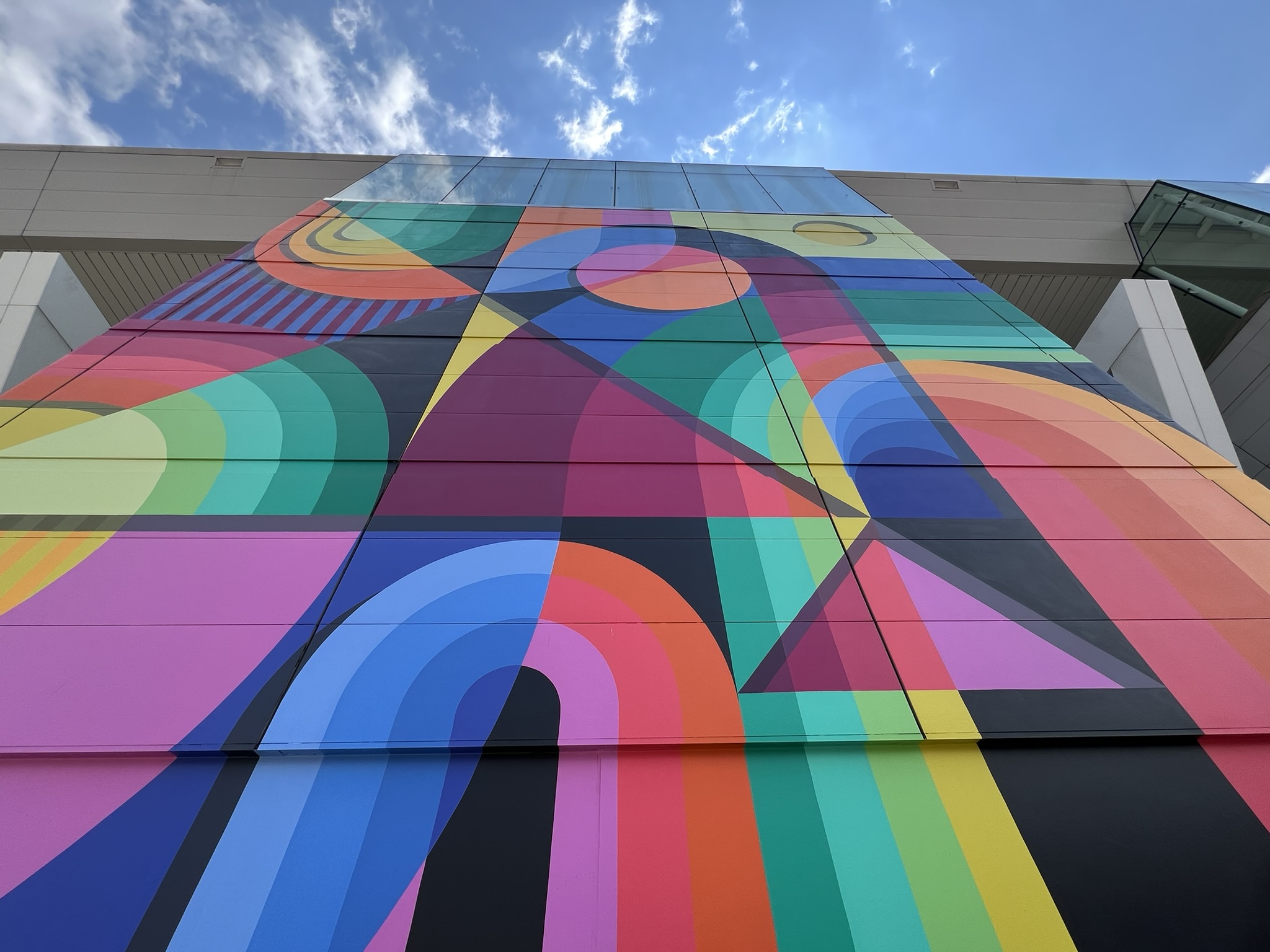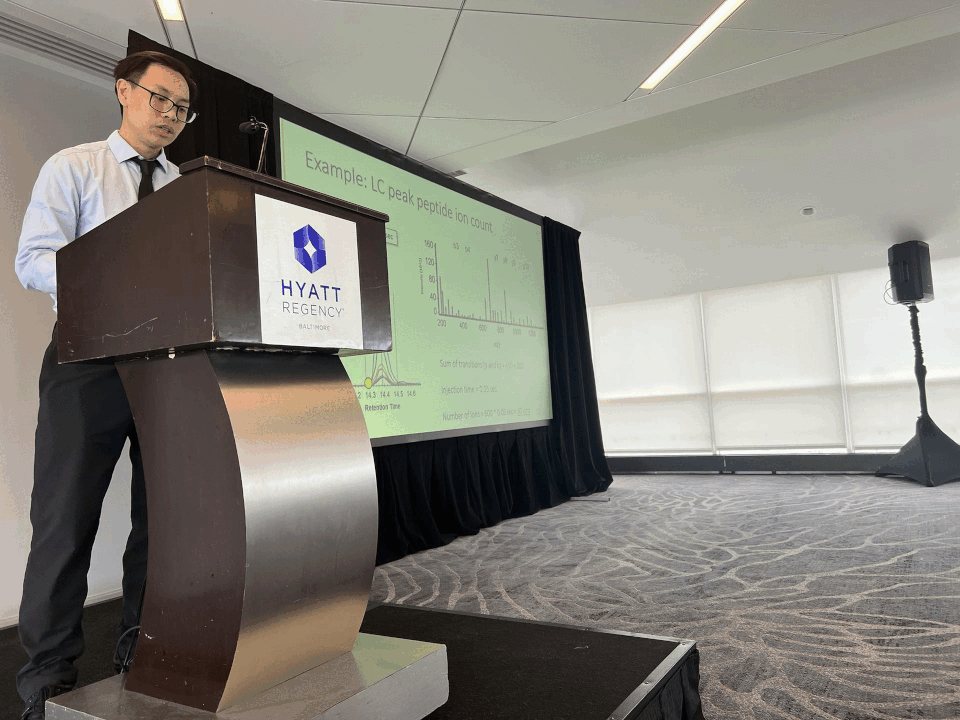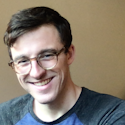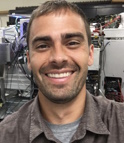Table of Contents |
guest 2025-11-08 |
Event Information
Posters
Speakers
Michael MacCoss
Brendan MacLean
Matt Champion
Emily Crawford
Lincoln Harris
Chris Hsu
Jonathan Krieger
Britt Lee
Marcelino Varona Ortiz
Philip Remes
Mike Riffle
Thanks!
Thanks to everyone who joined us in Baltimore for the Skyline User Group Meeting at ASMS 2025. It was great to meet with all of you passionate Skyline users and share the opportunity to experience varied presentations about recent work enabled by (and for) Skyline software!
Below are links to the speakers' pages with options to view their slides or watch their presentations as [video]s. At the bottom of this page, you will also find some photos from the event.
Thanks especially to all the wonderful speakers who volunteered their time and effort to share great presentations ranging from imputing missing data, to Skyline workflow tools, to pharmaceutical detection in water sources, and much more!
We hope these presentations long outlast the event itself, as previous years have.
Thank you! -- Brendan MacLean and Mike MacCoss, Event hosts
Michael J. MacCoss, Ph.D. (University of Washington): Introduction and event host
Brendan MacLean (MacCoss Lab, University of Washington): Status of the Skyline open-source software project 17 years after its inception [video]
The Skyline project started just after ASMS 2008 as a 2-year effort to bring better SRM/MRM software tools to the NCI-CPTAC Verification Working Group that could support the variety of mass spectrometers in use in participating laboratories. Nearly 15 years later, the Skyline project is a thriving proteomics community open-source collaboration supporting 6 mass spec instrument vendors, integrated with a wide variety of external software, with thousands of users worldwide and many thousands of instances started each week. (More info...)
Britt Lee (Thermo Fisher Scientific): Lipidomics at Scale: Skyline-Powered Targeted Workflows on the Stellar Mass Spectrometer [video]
The growing prevalence of metabolic disorders underscores the need for high-throughput lipidomics workflows that enable comprehensive, precise, and selective lipid quantification. Structurally related lipids with varying fatty acid compositions play distinct biological roles, making highly selective analysis essential for risk prediction, diagnostics, and translational research. Skyline provides a powerful and accessible platform for developing and optimizing targeted lipidomics methods, making it an ideal tool for nominal mass instruments like the Thermo Scientific Stellar MS. (More info...)
Matt Champion Ph.D. (University of Notre Dame): Skyline Workflows to Quantify N-terminal Acetylation Peptidoforms While Preserving Protein Abundance in Bottom-up Proteomics [video]
N-terminal Acetylation (N𝛼TA) is the co-and post-translational addition of an acetyl group to the N-terminus of a protein by N-acetyl transferases (NATs). It is a ubiquitous, but under-studied modification with a variety of roles in protein stability, trafficking and recognition. In mycobacteria, N𝛼TA is associated with increased virulence and several virulence factors are differentially acetylated with PTM.
(More info...)
Emily Crawford (University of North Carolina): Assessing Antidepressant Pharmaceuticals in the Environment through the Development of a Multidimensional Liquid Chromatography-Ion Mobility Spectrometry-Mass Spectrometry Library [video]
Antidepressant (AD) medications are globally prescribed to alleviate depression symptoms by altering neurotransmitter reuptake in the brain. Up to 90% of an orally administered AD dose is excreted from the body as either the parent chemical or pharmacologically active metabolites which remain active even at low concentrations. These molecules are not currently removed by wastewater treatment plants (WWTPs), posing great environmental and ecological concerns. To understand exposure risks, we developed methods to quantify 26 parent ADs and 16 metabolites in surface water with liquid chromatography, ion mobility spectrometry, and mass spectrometry (LC-IMS-MS).
(More info...)
Jonathan Krieger Ph.D. (Bruker): Improved targeted quantitation with diagonal-PASEF using Skyline [video]
Combining Data-Independent Acquisition (DIA) with Trapped Ion Mobility Separation (TIMS) reduces sample complexity by providing an additional dimension of separation, thereby increasing overall system peak capacity. This scan mode, termed dia-PASEF, employs fixed quadrupole isolation windows for ion selection in both the m/z and mobility panes. To further enhance the analytical performance, diagonal-PASEF has been developed, which optimizes the acquisition of the precursor ion cloud by continuously tracking its diagonal shape.
(More info...)
Chris Hsu (University of Washington): Bridging the Gap in Mass Spectrometry Hardware Evaluation: Ion counting in Skyline for Cross-Platform Comparisons [video]
The rapid advancement of mass spectrometry (MS) hardware has exposed a critical gap in performance evaluation. Traditional metrics, such as database search-derived peptide and protein identifications, remain rooted in qualitative assessments and don’t necessarily capture differences in instrument performance. New MS instruments continue to improve, generating data with improved sensitivity and speed, but analytical parameters, such as ion utilization efficiency, transmission, and quantitative precision, are rarely assessed. Even widely used methodologies like automatic gain control (AGC), which dynamically adjust ion populations to optimize detection, lack standardized frameworks to compare its effectiveness across platforms. This limits our ability to objectively evaluate hardware advancements.
(More info...)
Lightning Talks
Philip Remes Ph.D. (Thermo Fisher Scientific): Improved Peak Picking in Skyline using Concepts from Adaptive RT [video]
Targeted MS/MS methods validate the retention times (RT) and dissociation fragments of compounds, store these data in a library, and perform data analysis by integrating a RT range about the LC/MS features that most closely resemble the library data. Besides being exceedingly fast, this method has the advantage of registering a measurement value even when the compound is not present.
(More info...)
Lincoln Harris (University of Washington): Improved quantitative accuracy in data-independent acquisition proteomics via retention time boundary imputation [video]
Missing values in data-independent (DIA) acquisition proteomics reduce statistical power and reproducibility and make it difficult to compare across runs. Traditionally, missing values have been handled in one of two ways. The first is peptide identity propagation (PIP), in which peptide identifications from “donor” runs are transferred to unassigned MS2 features in “acceptor” runs. Popular methods for PIP include MaxQuant match-between-runs (MBR) feature and TRIC. The second way missing values are handled is “plug-in” imputation, in which statistical or machine learning methods are used to estimate missing quantitations using only the observed quantitations. Popular plug-in methods include Perseus and k-nearest neighbors (kNN).
(More info...)
Marcelino Varona Ortiz (Genentech): Traveling Wave Ion Mobility Spectrometry for the identification and quantitation of impurities in small molecule APIs [video]
In this presentation, I will speak of our group's recent work using Traveling Wave Ion Mobility Spectrometry (TWIMS) coupled with High Resolution Mass Spectrometry (HRMS) to characterize impurities in small molecule drug candidates. In addition, we have implemented a workflow with Skyline to the enable quantitation of some of these impurities. The developed methods have enabled the significant reduction of analysis times when compared to traditional chromatographic methods.
(More info...)
Mike Riffle (University of Washington): An automated workflow for de novo DIA searches using Nextflow, Cascadia, and Skyline [video]
Typically, DIA proteomics searches require a priori knowledge of expected peptide sequences to identify peptides in a sample. This can represent a very real practical limitation in fields such as environmental metaproteomics or microbiome analyses where the expected proteomes are not known.
(More info...)
Sponsors
 |
 |
 |
|
 |
 |
 | |
|
|
|
 |
 |
 |
 |
 |
|
 |
|
 |
 |
 |
|
Event Information
Welcome
The Skyline Team is pleased to announce this year's big event, the Annual Skyline User Group Meeting, which will be held in Baltimore, MD on Sunday afternoon before ASMS. We love seeing you all in-person -- so be sure to register and attend! We would like to thank the event sponsors (see below) for their generosity and interest in collaborating with the Skyline project on exciting new targeted and quantitative mass spectrometry techniques.
--Brendan
When: Sunday, June 1, 2025
12:00 - 1:00 pm : Lunch served
1:00 - 2:30 pm : Presentations
2:30 - 3:00 pm : Snacks and break-out discussions
3:00 - 4:30 pm : Presentations
Where: Hyatt Regency Baltimore Inner Harbor PISCES room, 15th Floor, 300 Light Street, Baltimore MD 21202 (map) - Just east of the Convention Center.
[registration closed]
We have closed our registration process but you can still attend! Please just come for "day of" registration. Sign in and write a name tag for yourself.
Michael J. MacCoss, Ph.D. (University of Washington): Introduction and event host
Brendan MacLean (MacCoss Lab, University of Washington): Status of the Skyline open-source software project 17 years after its inception
The Skyline project started just after ASMS 2008 as a 2-year effort to bring better SRM/MRM software tools to the NCI-CPTAC Verification Working Group that could support the variety of mass spectrometers in use in participating laboratories. Nearly 15 years later, the Skyline project is a thriving proteomics community open-source collaboration supporting 6 mass spec instrument vendors, integrated with a wide variety of external software, with thousands of users worldwide and many thousands of instances started each week. (More info...)
Britt Lee (Thermo Fisher Scientific): Lipidomics at Scale: Skyline-Powered Targeted Workflows on the Stellar Mass Spectrometer
The growing prevalence of metabolic disorders underscores the need for high-throughput lipidomics workflows that enable comprehensive, precise, and selective lipid quantification. Structurally related lipids with varying fatty acid compositions play distinct biological roles, making highly selective analysis essential for risk prediction, diagnostics, and translational research. Skyline provides a powerful and accessible platform for developing and optimizing targeted lipidomics methods, making it an ideal tool for nominal mass instruments like the Thermo Scientific Stellar MS. (More info...)
Matt Champion Ph.D. (University of Notre Dame): Skyline Workflows to Quantify N-terminal Acetylation Peptidoforms While Preserving Protein Abundance in Bottom-up Proteomics
N-terminal Acetylation (N𝛼TA) is the co-and post-translational addition of an acetyl group to the N-terminus of a protein by N-acetyl transferases (NATs). It is a ubiquitous, but under-studied modification with a variety of roles in protein stability, trafficking and recognition. In mycobacteria, N𝛼TA is associated with increased virulence and several virulence factors are differentially acetylated with PTM.
(More info...)
Emily Crawford (University of North Carolina): Assessing Antidepressant Pharmaceuticals in the Environment through the Development of a Multidimensional Liquid Chromatography-Ion Mobility Spectrometry-Mass Spectrometry Library
Antidepressant (AD) medications are globally prescribed to alleviate depression symptoms by altering neurotransmitter reuptake in the brain. Up to 90% of an orally administered AD dose is excreted from the body as either the parent chemical or pharmacologically active metabolites which remain active even at low concentrations. These molecules are not currently removed by wastewater treatment plants (WWTPs), posing great environmental and ecological concerns. To understand exposure risks, we developed methods to quantify 26 parent ADs and 16 metabolites in surface water with liquid chromatography, ion mobility spectrometry, and mass spectrometry (LC-IMS-MS).
(More info...)
Jonathan Krieger Ph.D. (Bruker): Improved targeted quantitation with diagonal-PASEF using Skyline
Combining Data-Independent Acquisition (DIA) with Trapped Ion Mobility Separation (TIMS) reduces sample complexity by providing an additional dimension of separation, thereby increasing overall system peak capacity. This scan mode, termed dia-PASEF, employs fixed quadrupole isolation windows for ion selection in both the m/z and mobility panes. To further enhance the analytical performance, diagonal-PASEF has been developed, which optimizes the acquisition of the precursor ion cloud by continuously tracking its diagonal shape.
(More info...)
Chris Hsu (University of Washington): Bridging the Gap in Mass Spectrometry Hardware Evaluation: Ion counting in Skyline for Cross-Platform Comparisons
The rapid advancement of mass spectrometry (MS) hardware has exposed a critical gap in performance evaluation. Traditional metrics, such as database search-derived peptide and protein identifications, remain rooted in qualitative assessments and don’t necessarily capture differences in instrument performance. New MS instruments continue to improve, generating data with improved sensitivity and speed, but analytical parameters, such as ion utilization efficiency, transmission, and quantitative precision, are rarely assessed. Even widely used methodologies like automatic gain control (AGC), which dynamically adjust ion populations to optimize detection, lack standardized frameworks to compare its effectiveness across platforms. This limits our ability to objectively evaluate hardware advancements.
(More info...)
Lightning Talks
Philip Remes Ph.D. (Thermo Fisher Scientific): Improved Peak Picking in Skyline using Concepts from Adaptive RT
Targeted MS/MS methods validate the retention times (RT) and dissociation fragments of compounds, store these data in a library, and perform data analysis by integrating a RT range about the LC/MS features that most closely resemble the library data. Besides being exceedingly fast, this method has the advantage of registering a measurement value even when the compound is not present.
(More info...)
Lincoln Harris (University of Washington): Improved quantitative accuracy in data-independent acquisition proteomics via retention time boundary imputation
Missing values in data-independent (DIA) acquisition proteomics reduce statistical power and reproducibility and make it difficult to compare across runs. Traditionally, missing values have been handled in one of two ways. The first is peptide identity propagation (PIP), in which peptide identifications from “donor” runs are transferred to unassigned MS2 features in “acceptor” runs. Popular methods for PIP include MaxQuant match-between-runs (MBR) feature and TRIC. The second way missing values are handled is “plug-in” imputation, in which statistical or machine learning methods are used to estimate missing quantitations using only the observed quantitations. Popular plug-in methods include Perseus and k-nearest neighbors (kNN).
(More info...)
Marcelino Varona Ortiz (Genentech): Traveling Wave Ion Mobility Spectrometry for the identification and quantitation of impurities in small molecule APIs
In this presentation, I will speak of our group's recent work using Traveling Wave Ion Mobility Spectrometry (TWIMS) coupled with High Resolution Mass Spectrometry (HRMS) to characterize impurities in small molecule drug candidates. In addition, we have implemented a workflow with Skyline to the enable quantitation of some of these impurities. The developed methods have enabled the significant reduction of analysis times when compared to traditional chromatographic methods.
(More info...)
Mike Riffle (University of Washington): An automated workflow for de novo DIA searches using Nextflow, Cascadia, and Skyline
Typically, DIA proteomics searches require a priori knowledge of expected peptide sequences to identify peptides in a sample. This can represent a very real practical limitation in fields such as environmental metaproteomics or microbiome analyses where the expected proteomes are not known.
(More info...)
Sponsors
 |
 |
 |
|
 |
 |
 | |
Posters
|
MOG pm 02:30 Evaluation of a modified Orbitrap Astral mass spectrometer for quantitative proteomics – beyond identification lists; Michael J MacCoss1 ; Chris Hsu1 ; Nicholas Shulman1 ; Anna Pashkova2 ; Deanna L Plubell1 ; Eugen Damoc2 ; Hamish Stewart2 ; Johannes Petzoldt2 ; Brendan MacLean1 ; Philip Remes3 ; Andrew N Hoofnagle4 ; Alexander Makarov2 ; Christian Hock2 ; Vlad Zabrouskov3 ; Christine C Wu1 ; 1University of Washington - Genome Sciences, Seattle, WA; 2Thermo Fisher Scientific (Bremen) GmbH, Bremen, Germany; 3Thermo Fisher Scientific, San Jose, California; 4University of Washington, Seattle, WA TOA pm 03:50 Closing the gap between targeted and untargeted measurements using intelligent data acquisition on Stellar MS; Lilian Randolph Heil1 ; Cristina Jacob2 ; Nicholas Shulman3 ; Brendan X. MacLean3 ; Michael J. MacCoss3 ; Philip Remes1 ; 1Thermo Fisher Scientific, San Jose, CA; 2ThermoFisher Scientific, San Jose, CA; 3University of Washington, Seattle, WA WOD am 08:50 Understanding cellular and global molecular dynamics during spleen aging using a multiomics approach; Katarina Vlajic1 ; Alison Luciano2 ; Gennifer E Merrihew1 ; Michael Riffle1 ; Kristine A Tsantilas1 ; Michael J MacCoss1 ; Gary A Churchill2 ; Devin K Schweppe1 ; 1University of Washington, Seattle, WA; 2The Jackson Laboratory, Bar Harbor, ME ThOA pm 02:30 Carafe enables high quality in silico spectral library generation for data-independent acquisition proteomics; Bo Wen1 ; Chris Hsu1 ; Wen-Feng Zeng2 ; Michael Riffle1 ; Alexis Chang1 ; Miranda Mudge1 ; Brook Nunn1 ; David Shteynberg1 ; Brendan MacLean1 ; Matthew D. Berg1 ; Judit Villen1 ; Michael J. MacCoss1 ; William S. Noble1, 3; 1Department of Genome Sciences, University of Washington, Seattle, WA; 2Department of Proteomics and Signal Transduction, Max Planck Institute of Biochemistry, Munich, Germany; 3Paul G. Allen School of Computer Science and Engineering, University of Washington, Seattle, WA MP 461 Proteomic Data Commons: Empowering Cancer Research Through Comprehensive Proteomic Data; Alexander Pilozzi1 ; Yin Lu1 ; Karen A Ketchum1 ; Nathan Edwards2 ; Michael Holck1 ; Deepak Singhal1 ; Paul A Rudnick3 ; Michael MacCoss4 ; Aaron Maurais4 ; Sudha Venkatachari5 ; Ratna R Thangudu1 ; 1 ICF, Rockville, MD; 2Georgetown University, Washington, DC; 3Spectragen Informatics, Bainbridge Island, WA; 4University of Washington, Seattle, WA; 5Frederick National Laboratory, Rockville, MD TP 193 DIA for the masses: strategies for implementation in unit resolution; Deanna L Plubell1 ; Christine C. Wu1 ; Bo Wen1 ; Fengchao Yu2 ; Philip M. Remes3 ; Lilian R Heil3 ; Alexey I. Nesvizhskii4 ; Michael J MacCoss1 ; 1University of Washington, Seattle, WA; 2University of Michigan, Ann Arbor, Michigan; 3Thermo Fisher Scientific, San Jose, CA; 4University of Michigan, Ann Arbor, MI TP 198 Extending LOD/LOQ Estimation and Quantitative Benchmarking for High-Throughput Proteomics; Lindsay K Pino1 ; Seth Just2 ; Daniele Canzani1 ; Jack Penny3 ; Ben Collins3 ; Sebastian J. Paez1 ; Michael Riffle4 ; Michael J. MacCoss4 ; William E. Fondrie1 ; Alexander J. Federation1 ; 1Talus Bioscience, Seattle, WA; 2Seer, Inc, Redwood City, CA; 3Queen's University Belfast, Belfast, United Kingdom; 4University of Washington, Seattle, WA TP 492 Improved quantitative accuracy in data-independent acquisition proteomics via retention time boundary imputation; Lincoln J Harris1 ; Michael Riffle1 ; Michael J. MacCoss1 ; William S. Noble1 ; 1University of Washington, Seattle, WA TP 515 Introduction of AlphaPeptDeep and Carafe Automated AI Spectral Library Construction in Skyline; David Shteynberg1 ; Bo Wen1 ; Nicholas Shulman1 ; Matthew C Chambers1 ; Brian S. Pratt1 ; William S. Noble1 ; Michael J MacCoss1 ; Brendan X. MacLean1 ; 1University of Washington, Seattle, WA WP 316 Application of Concepts from Adaptive Retention Time Improves the Robustness of LC Peak Integration in Targeted MSn Experiments; Philip M Remes1 ; Lilian H. Heil1 ; Cristina C. Jacob1 ; Nicholas Shulman2 ; Brendan X. MacLean2 ; Qin Fu1 ; Jihyeon Lee3 ; Jennifer Van Eyk3 ; Michael J. MacCoss2 ; 1Thermo Fisher Scientific, San Jose, CA; 2University of Washington, Seattle, WA; 3Cedars Sinai Medical Center, Los Angeles, CA WP 334 Conditional use of search-engine-determined integration boundaries in Skyline 25.1; Nicholas Shulman1 ; Michael Riffle1 ; Christine C Wu1 ; Brendan MacLean1 ; Michael J MacCoss1 ; 1University of Washington - Genome Sciences, Seattle, WA WP 395 Enhancing plasma proteome profiling through costeffective, robust and high-throughput workflows based on hyper-porous magnetic beads; Amy Van Graan1 ; Ireshyn S Govender2 ; Christine Wu3 ; Michael J. MacCoss3 ; Isak Gerber1 ; Justin Jordaan1 ; Previn Naicker1 ; 1ReSyn Biosciences, Pretoria, South Africa; 2Council for scientific and industrial research, Pretoria, South Africa; 3University of Washington, Seattle, WA WP 678 Simplifying Clinical Mass Spectrometry: Coupling the SISCAPA Workflow with the Stellar Mass Spectrometer for Protein Biomarker Quantification; Richard Yip1 ; Deanna L Plubell2 ; Andrew Hettle1 ; Morteza Razavi1 ; Andrew N Hoofnagle2 ; Michael J MacCoss2 ; Leigh Anderson1 ; 1SISCAPA Assay Technologies Inc., Victoria, BC; 2University of Washington, Seattle, WA ThP 053 Plasma Proteomics Using Mag-Net and Proteograph XT Enrichment Enables Multi-Faceted Biomarker Discovery with Complementary Protein and Peptide Coverage; Blake L Tsu1 ; Stefanie N Kairs1 ; Sangtae Kim1 ; Goo Jun2 ; Craig L Hanis2 ; Eric L Brown2 ; Christine C Wu3 ; Michael J MacCoss3 ; Christopher A. Barnes1 ; 1NGeneBioAI, San Diego, CA; 2Department of Epidemiology, School of Public Health, UTHealth Houston, Houston, TX; 3University of Washington - Genome Sciences, Seattle, WA ThP 295 Skyline and msconvert in Docker: broadening access to powerful MS data processing tools beyond Windows environments; Matthew C Chambers1 ; Brendan X. MacLean1 ; Michael J MacCoss1 ; 1University of Washington - Genome Sciences, Seattle, WA ThP 296 Limelight – a generalized web app for analyzing, visualizing, and sharing DDA proteomics data and results; Michael Riffle1 ; Alex Zelter1 ; Daniel Jaschob1 ; Michael R Hoopmann1, 2; Danielle A Faivre1 ; Robert L Moritz2 ; Trisha N Davis1 ; Michael J MacCoss1 ; Nina Isoherranen1 ; 1University of Washington, Seattle, WA; 2 Institute for Systems Biology, Seattle, WA ThP 537 Peptide quantification in cerebrospinal fluid for the analysis of neurodegenerative diseases; Gennifer E Merrihew1 ; Deanna L Plubell1 ; Michael Riffle1 ; Bo Wen1 ; Jessica Becker2 ; Julia E Robbins1 ; Brian C. Searle3 ; Christine Wu1 ; Kathleen Poston4 ; Thomas Montine4 ; Andrew N Hoofnagle2 ; Michael J MacCoss1 ; 1University of Washington - Genome Sciences, Seattle, WA; 2University of Washington, Seattle, WA; 3The Ohio State University, Columbus, OH; 4Stanford University, Stanford, CA ThP 674 Addressing cerebellum tissue heterogeneity with spatial proteomics at low input; Chris Hsu1 ; Amber Nolan1 ; Christine C. Wu1 ; C. Dirk Keene1 ; Michael J MacCoss1 ; 1University of Washington, Seattle, WA 07 Towards Guidelines for DIA Reporting Criteria Data Independent Acquisition Interest Group Presiders: Mike MacCoss, Michael Ford Ballroom IV |
Speakers
Here are biographies and abstracts for this year's speakers -- each users of Skyline -- scheduled to speak at the Skyline User Group Meeting at ASMS 2025 in Baltimore, MD.
Michael MacCoss
 |
Michael MacCoss Ph.D., became interested in biomedical applications of mass spectrometry while working in Dr. Patrick Griffin’s protein mass spectrometry lab at Merck Research Laboratories. He obtained a Ph.D. with Professor Dwight Matthews and pursued a postdoc with Professor John R. Yates III. In 2004 he started the MacCoss lab at the University of Washington and it became obvious that while mass spectrometry data could be collected quickly and robustly, the lack of computational tools for the visualization and analysis of these data was a stumbling block. In 2008 he hired Brendan MacLean with the goal of developing professional quality software tools for quantitative proteomics. Mike has worked closely with the Skyline development team and our outstanding group of laboratory scientists and collaborators to ensure that our software uses analytical approaches that have been thoroughly vetted by the mass spectrometry community. |
Brendan MacLean
 |
Brendan MacLean worked at Microsoft for 8 years in the 1990s where he was a lead developer and development manager for the Visual C++/Developer Studio Project. Since leaving Microsoft, Brendan has been the Vice President of Engineering for Westside Corporation, Director of Engineering for BEA Systems, Inc., Sr. Software Engineer at the Fred Hutchinson Cancer Research Center, and a founding partner of LabKey Software. In this last position he was one of the key programmers responsible for the Computational Proteomics Analysis System (CPAS), made significant contributions to the development of X!Tandem and the Trans Proteomic Pipeline, and created the LabKey Enterprise Pipeline. Since that time, he has worked as a Sr. Software Engineer within the MacCoss lab and led all aspects of design, development and support in creating the Skyline Targeted Mass Spectrometry Environment and its growing worldwide user community. |
Status of the Skyline open-source software project 17 years after its inception
The Skyline project started just after ASMS 2008 as a 2-year effort to bring better SRM/MRM software tools to the NCI-CPTAC Verification Working Group that could support the variety of mass spectrometers in use in participating laboratories. Nearly 17 years later, the Skyline project is a thriving mass spectrometry community open-source collaboration supporting 6 mass spec instrument vendors, integrated with a wide variety of external software, with many thousands of users worldwide and over fourteen thousand instances started each week. Read More- Supporting new upstream processing pipelines
- Supporting new instrument acquisition methods
- Enhanced visualizations to better understand input data
- Strong industry support from instrument vendors
- Courses, workshops, webinars and other efforts to create instructional resources for the Skyline community
[PDF]
Matt Champion

|
Matt Champion, Ph.D., earned his B.S. in Microbiology from The University of Iowa and his Ph.D. at Texas A&M University in Biochemistry. After that he worked at Applied Biosystems from 2003-2009 and worked as a research professor in the mass spectrometry and proteomics facility at Notre Dame. In 2019 he started his own research group which includes development of proteomics methods, processing and visualization for the analysis of proteomes in microbial systems and pathogens. |
Skyline Workflows to Quantify N-terminal Acetylation Peptidoforms While Preserving Protein Abundance in Bottom-up Proteomics
N-terminal Acetylation (N𝛼TA) is the co-and post-translational addition of an acetyl group to the N-terminus of a protein by N-acetyl transferases (NATs). It is a ubiquitous, but under-studied modification with a variety of roles in protein stability, trafficking and recognition. In mycobacteria, N𝛼TA is associated with increased virulence and several virulence factors are differentially acetylated with PTM. Read More[PDF]
Emily Crawford

|
Emily Crawford completed her B.S. in Chemistry in 2023 at the Georgia Institute of Technology in Atlanta, GA. She is currently an analytical chemistry Ph.D. candidate at the University of North Carolina at Chapel Hill in Dr. Erin Baker’s laboratory. Here, her research focuses on optimizing separation and mass spectrometry techniques to assess the effects of pharmaceutical pollution on the environment. |
Assessing Antidepressant Pharmaceuticals in the Environment through the Development of a Multidimensional Liquid Chromatography-Ion Mobility Spectrometry-Mass Spectrometry Library
Antidepressant (AD) medications are globally prescribed to alleviate depression symptoms by altering neurotransmitter reuptake in the brain. Up to 90% of an orally administered AD dose is excreted from the body as either the parent chemical or pharmacologically active metabolites which remain active even at low concentrations. These molecules are not currently removed by wastewater treatment plants (WWTPs), posing great environmental and ecological concerns. To understand exposure risks, we developed methods to quantify 26 parent ADs and 16 metabolites in surface water with liquid chromatography, ion mobility spectrometry, and mass spectrometry (LC-IMS-MS). Read More[PDF]
Lincoln Harris

|
Lincoln Harris is a fifth year PhD student in the Genome Sciences department at the University of Washington. Prior to graduate school, he worked on data analysis and methods development for single-cell RNA-sequencing. In Genome Science, he made the transition to proteomics and focused on developing and evaluating methods for handling missing values in quantitative proteomics. He's a member of the Noble lab but works closely with the MacCoss lab on several projects. |
Improved quantitative accuracy in data-independent acquisition proteomics via retention time boundary imputation
Missing values in data-independent (DIA) acquisition proteomics reduce statistical power and reproducibility and make it difficult to compare across runs. Traditionally, missing values have been handled in one of two ways. The first is peptide identity propagation (PIP), in which peptide identifications from “donor” runs are transferred to unassigned MS2 features in “acceptor” runs. Popular methods for PIP include MaxQuant match-between-runs (MBR) feature and TRIC. The second way missing values are handled is “plug-in” imputation, in which statistical or machine learning methods are used to estimate missing quantitations using only the observed quantitations. Popular plug-in methods include Perseus and k-nearest neighbors (kNN). Read More[PDF]
Chris Hsu

|
Chris Hsu completed his B.S. in Biochemistry in 2018 at the UW. Currently, he is a Genome Sciences Ph.D. candidate at the UW in Dr. Michael MacCoss’s lab. His research focuses on developing new methods to compare quantitative analysis of instruments and applying these new methods to answer questions about spatial proteomics. He uses Skyline for external tool development and extracting ion count information from peptides for his analysis. |
Bridging the Gap in Mass Spectrometry Hardware Evaluation: Ion counting in Skyline for Cross-Platform Comparisons
The rapid advancement of mass spectrometry (MS) hardware has exposed a critical gap in performance evaluation. Traditional metrics, such as database search-derived peptide and protein identifications, remain rooted in qualitative assessments and don’t necessarily capture differences in instrument performance. New MS instruments continue to improve, generating data with improved sensitivity and speed, but analytical parameters, such as ion utilization efficiency, transmission, and quantitative precision, are rarely assessed. Even widely used methodologies like automatic gain control (AGC), which dynamically adjust ion populations to optimize detection, lack standardized frameworks to compare its effectiveness across platforms. This limits our ability to objectively evaluate hardware advancements. Read More[PDF]
Jonathan Krieger

|
Jonathan Krieger is the Head of Research at Bruker ProteoScape, where he has been contributing significantly since November 2021. His expertise spans various aspects of computational proteomics. Prior to his current role, Jonathan served as the Applications Manager and Core Facility Manager at Bioinformatics Solutions Inc., the creators of PEAKS software. He also gained valuable experience at the SPARC BioCentre, the core Mass Spectrometry facility at SickKids hospital. Based in Toronto, Canada, Jonathan's research at Bruker encompasses software development, data science, and computational proteomics. |
Improved targeted quantitation with diagonal-PASEF using Skyline
Combining Data-Independent Acquisition (DIA) with Trapped Ion Mobility Separation (TIMS) reduces sample complexity by providing an additional dimension of separation, thereby increasing overall system peak capacity. This scan mode, termed dia-PASEF, employs fixed quadrupole isolation windows for ion selection in both the m/z and mobility panes. To further enhance the analytical performance, diagonal-PASEF has been developed, which optimizes the acquisition of the precursor ion cloud by continuously tracking its diagonal shape. Read More[PDF]
Britt Lee

|
Britt Lee My experiences from my graduate work, postdoc and industry are all focused in the small molecule and multiomics space, specializing in metabolomics, lipidomics, and proteomics. Now at Thermo Fisher Scientific, I focus on developing applications that advance omics research using cutting-edge mass spectrometry technologies. My work aims to bridge the gap between emerging analytical tools and practical solutions for high-throughput, high-precision biomolecular analysis. |
Lipidomics at Scale: Skyline-Powered Targeted Workflows on the Stellar Mass Spectrometer
The growing prevalence of metabolic disorders underscores the need for high-throughput lipidomics workflows that enable comprehensive, precise, and selective lipid quantification. Structurally related lipids with varying fatty acid compositions play distinct biological roles, making highly selective analysis essential for risk prediction, diagnostics, and translational research. Skyline provides a powerful and accessible platform for developing and optimizing targeted lipidomics methods, making it an ideal tool for nominal mass instruments like the Thermo Scientific Stellar MS. Read More[PDF]
Marcelino Varona Ortiz

|
Marcelino Varona Ortiz I received my B.S in Biology and Chemistry from Concordia University Nebraska and PhD in Analytical Chemistry from Iowa State University. Currently I am a Principal Scientist in the Synthetic Molecule Analytical Chemistry department at Genentech. I am a CMC analytical lead who is responsible for the control strategy and characterization of synthetic molecules within our portfolio. Over the last couple of years I have been using High Resolution Ion Mobility Mass Spectrometry as a tool to enable the characterization of a variety of small molecule compounds. |
Traveling Wave Ion Mobility Spectrometry for the identification and quantitation of impurities in small molecule APIs
In this presentation, I will speak of our group's recent work using Traveling Wave Ion Mobility Spectrometry (TWIMS) coupled with High Resolution Mass Spectrometry (HRMS) to characterize impurities in small molecule drug candidates. In addition, we have implemented a workflow with Skyline to the enable quantitation of some of these impurities. The developed methods have enabled the significant reduction of analysis times when compared to traditional chromatographic methods.[PDF]
Philip Remes

|
Philip Remes Ph.D., is a senior research scientist in the R&D department of Thermo Fisher Scientific in San Jose, California. He received his Ph.D. in Gary Glish’s lab at the University of Chapel Hill, North Carolina, where he worked on quadrupole ion trap and mass filter instrumentation. At Thermo, he worked with Jae Schwartz on instrument control software, ion trap analyzers, detectors and simulations for the LTQ Velos platform. Later he did similar work as a part of Mike Senko’s Tribrid development team on the Fusion, Lumos, and Eclipse projects. In recent years, Philip has continued working on ion trap technology as the technical lead of the Stellar project, branching out to learn about applications and get first-hand experience in how they can benefit from improvements in hardware, instrument control, signal processing, and informatics. |
Improved Peak Picking in Skyline using Concepts from Adaptive RT
Targeted MS/MS methods validate the retention times (RT) and dissociation fragments of compounds, store these data in a library, and perform data analysis by integrating a RT range about the LC/MS features that most closely resemble the library data. Besides being exceedingly fast, this method has the advantage of registering a measurement value even when the compound is not present. Read More[PDF]
Mike Riffle

|
Mike Riffle has many years of experience in bioinformatics, data science, and statistics; and has worked with several leading academic proteomics laboratories in the US. He is a proponent of open and reproducible science, and has produced several open source tools for proteomics data visualization, including Proxl (protein cross-linking) and, more recently, Limelight (generalized proteomics data visualization and sharing). Michael has a Bachelors in Molecular and Cellular Biology from the University of Washington and his Masters in Computer Science from the University of Illinois Urbana-Champaign. |
An automated workflow for de novo DIA searches using Nextflow, Cascadia, and Skyline
Typically, DIA proteomics searches require a priori knowledge of expected peptide sequences to identify peptides in a sample. This can represent a very real practical limitation in fields such as environmental metaproteomics or microbiome analyses where the expected proteomes are not known. Read More[PDF]